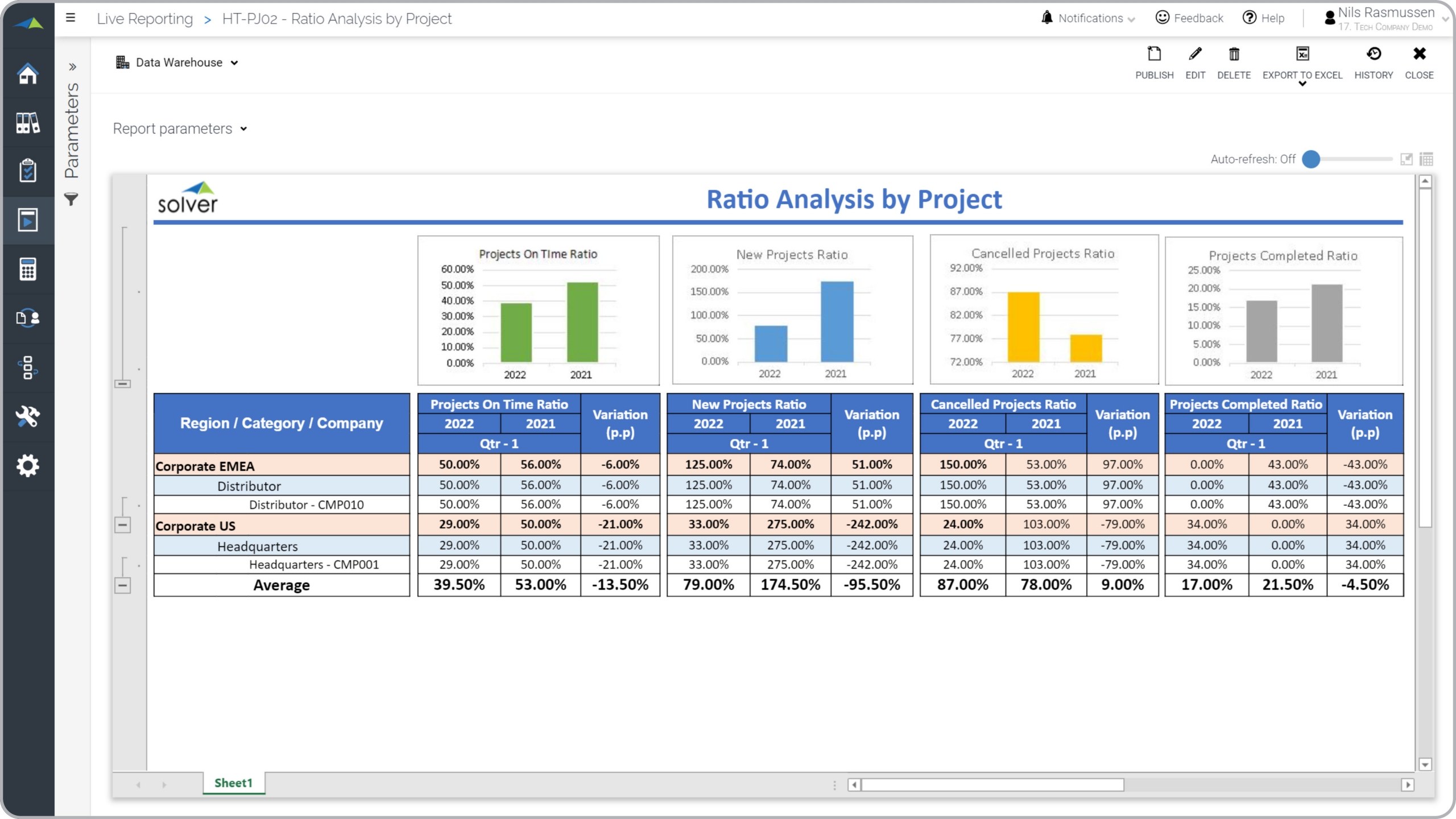Project Status Overview Report
What is a
Project Status Overview Report
? Project overview reports are considered operational analysis tools and are used by professional service executives and consulting managers to get a clear picture of the stages of their projects' life cycle and status ratios compared to the prior year. Some of the main functionality in this type of report is that it provides a year-over-year comparison of four metrics, including charts: 1) Projects on time, 2) New projects, 3) Cancelled projects, and 4) Completed projects. All these metrics are shown as ratios across companies/locations grouped by category and region. You find an example of this type of report below.
Purpose of
Project Status Overview Reports Technology companies use Project Status Overview Reports to analyze performance by stage and then compare it to the same metrics for the prior year to look for important variances. When used as part of good business practices in Project Management departments, a company can improve its professional services strategies and related revenues, and it can reduce the chances that managers miss out on important trends.
Example of a
Project Status Overview Report Here is an example of a Project Status Summary Report with ratios and comparisons to prior year. [caption id="" align="alignnone" width="2560"]
 Example of a Project Status Overview Report[/caption] You can find hundreds of additional examples
here
Who Uses This Type of
Report
? The typical users of this type of report are: Project Management Offices (PMO), Directors of Services, Consulting Managers.
Other Reports Often Used in Conjunction with
Project Status Overview Reports Progressive Project Management departments sometimes use several different Project Status Overview Reports, along with detailed project reports, project dashboards, billing reports, project budgets and forecasts and other management and control tools.
Where Does the Data for Analysis Originate From? The Actual (historical transactions) data typically comes from enterprise resource planning (ERP) systems like: Microsoft Dynamics 365 (D365) Finance, Microsoft Dynamics 365 Business Central (D365 BC), Microsoft Dynamics AX, Microsoft Dynamics NAV, Microsoft Dynamics GP, Microsoft Dynamics SL, Sage Intacct, Sage 100, Sage 300, Sage 500, Sage X3, SAP Business One, SAP ByDesign, Acumatica, Netsuite and others. In analyses where budgets or forecasts are used, the planning data most often originates from in-house Excel spreadsheet models or from professional corporate performance management (CPM/EPM) solutions.
What Tools are Typically used for Reporting, Planning and Dashboards? Examples of business software used with the data and ERPs mentioned above are:
Example of a Project Status Overview Report[/caption] You can find hundreds of additional examples
here
Who Uses This Type of
Report
? The typical users of this type of report are: Project Management Offices (PMO), Directors of Services, Consulting Managers.
Other Reports Often Used in Conjunction with
Project Status Overview Reports Progressive Project Management departments sometimes use several different Project Status Overview Reports, along with detailed project reports, project dashboards, billing reports, project budgets and forecasts and other management and control tools.
Where Does the Data for Analysis Originate From? The Actual (historical transactions) data typically comes from enterprise resource planning (ERP) systems like: Microsoft Dynamics 365 (D365) Finance, Microsoft Dynamics 365 Business Central (D365 BC), Microsoft Dynamics AX, Microsoft Dynamics NAV, Microsoft Dynamics GP, Microsoft Dynamics SL, Sage Intacct, Sage 100, Sage 300, Sage 500, Sage X3, SAP Business One, SAP ByDesign, Acumatica, Netsuite and others. In analyses where budgets or forecasts are used, the planning data most often originates from in-house Excel spreadsheet models or from professional corporate performance management (CPM/EPM) solutions.
What Tools are Typically used for Reporting, Planning and Dashboards? Examples of business software used with the data and ERPs mentioned above are:
- Native ERP report writers and query tools
- Spreadsheets (for example Microsoft Excel)
- Corporate Performance Management (CPM) tools (for example Solver)
- Dashboards (for example Microsoft Power BI and Tableau)
Corporate Performance Management (CPM) Cloud Solutions and More Examples
June 6, 2021
TAGS:
Reporting,
Solver,
report writer,
Microsoft,
template,
practice,
Acumatica,
metric,
Netsuite,
Finance,
planning,
GP,
status,
Business Central,
tech,
excel,
ax,
forecast,
Budget,
technology,
Dynamics 365,
budgeting,
Cloud,
Software,
Tableau,
SAP,
example,
best,
Sage,
BC,
D365,
NAV,
Intacct,
Variance,
project,
CPM,
report,
SL,
Management,
dynamics,
Power BI,
project status ratios,
project dashboard

